Pressure Gauges
Pressure gauges, also known as pressure gages, are devices used to measure and indicate the pressure of gases or liquids within a closed system or vessel. These instruments are suitable for monitoring a wide range of fluids and gases.
Pressure Gauge Applications
Pressure gauges are used to monitor and display the internal pressure in vessels or systems—especially where dynamic operating conditions require continuous measurement. Reliable pressure readings are critical in applications where the safe and effective operation of equipment depends directly on precise gauge readings.
Pressure gauges are commonly found in a range of industrial systems and products, including specialty tanks like fire extinguishers and medical gas cylinders, high purity semiconductor gas and liquid systems, tire inflation, pressure canning, pesticide spraying equipment, and nitrous systems for bottles and solenoids.
Pressure Gauge FAQ
What is the main purpose of a pressure gauge?
A pressure gauge measures and displays the pressure of gases or liquids within a closed system, ensuring safe operation and performance. It helps detect leaks, monitor fluid intensity, and maintain precise pressure control in industrial, commercial, and laboratory applications.
How does a Bourdon tube pressure gauge work?
A Bourdon tube pressure gauge uses a curved, thin-walled metal tube that straightens as pressure increases. This movement drives the pointer on the dial, providing a visual indication of system pressure. It can measure ranges from -1 bar up to 1000 bar with high reliability.
What materials are commonly used in pressure gauge construction?
Pressure gauges are typically made from stainless steel, brass, or plastic. Stainless steel is preferred for its corrosion resistance and durability, especially in harsh or sanitary environments like chemical plants or food processing facilities.
What are the main types of pressure gauges?
Common types include differential, digital, vacuum, oil, water, and high-pressure gauges. Each type is designed for specific fluids, pressure ranges, and applications, from automotive systems to semiconductor manufacturing and hydraulic equipment.
Why are liquid-filled pressure gauges used in industrial systems?
Liquid-filled gauges contain fluids like glycerin or silicone oil to protect internal components from vibration, pulsation, and moisture. This design enhances accuracy and extends service life in demanding environments such as hydraulic and pneumatic systems.
What standards apply to pressure gauges in the United States?
Pressure gauges used in the U.S. should meet ANSI or ASME standards, which ensure performance, safety, and measurement accuracy across industrial and commercial applications.
How should a pressure gauge be installed for accurate readings?
Install the gauge securely on a stable surface, isolated from vibration and temperature extremes. Use a shut-off valve between the system and gauge to allow safe maintenance without disrupting pressure monitoring.
How often should pressure gauges be inspected or maintained?
Routine inspections help maintain safety and accuracy. The frequency depends on operating conditions and should be determined with the manufacturer’s guidance, checking for wear, damaged threads, or socket issues.
The History of Pressure Gauges
- Pressure Gauges in the 17th Century
- The origins of pressure measurement can be traced to the 17th century with the development of the barometer, which measures atmospheric pressure. The barometer was invented in the mid-1600s, with Evangelista Torricelli generally credited as its inventor in 1643. Inspired by Galileo Galilei’s ideas about vacuums, Torricelli’s work demonstrated that atmospheric pressure could support a column of liquid. In 1648, Blaise Pascal used Torricelli’s barometer to show that air pressure decreases at higher altitudes.
- In 1654, German scientist Otto von Guericke created a vacuum pump, demonstrating the effects of air pressure through the famous Magdeburg hemispheres experiment. He evacuated air from two hemispheres, which teams of horses could not pull apart until the pressure was equalized. This experiment highlighted the significant force exerted by atmospheric pressure.
- In 1662, Robert Boyle, an Anglo-Irish physicist and chemist, published Boyle’s Law, describing the inverse relationship between pressure and volume. Boyle confirmed this relationship through detailed experiments involving compression and decompression.
- Pressure Gauges in the 1800s
- In 1802, Joseph Louis Gay-Lussac introduced Gay-Lussac’s law, stating that for a constant mass and volume, gas pressure rises linearly with temperature.
- Between 1849 and 1850, Eugene Bourdon, a French watchmaker and engineer, invented the Bourdon tube gauge, revolutionizing pressure sensing by enabling accurate measurements across various environments, such as steam generators. This type of gauge, featuring a curved tube as the sensing element, remains widely used today. Early gauges improved safety for locomotive and machine operators working with high-pressure boilers, reducing the risk of catastrophic accidents. In 1893, French physicist Émile Hilaire Amagat used dead-weight pistons to calibrate pressure gauges, further improving measurement accuracy in the late 19th century.
- Pressure Gauges in the 20th Century
- During the 20th century, advancements in technology led to significant improvements in pressure gauges. In 1930, engineers developed the first electrically-powered gauge products. By the 1950s, manufacturers began using durable materials such as plastic and stainless steel for gauge cases.
- Modern pressure gauges continue to evolve for accuracy and reliability. As technology advances, gauges offer more precise readings with lower margins of error. Analog dials often feature multiple measurement units, and internal components are engineered for greater sensitivity. Hydrostatic gauges now use various liquids for optimal accuracy, and aneroid gauges utilize innovative membrane materials for improved detection of pressure changes.
Pressure Gauge Design
Pressure gauges are available in a variety of styles, sizes, and materials to suit different applications. Display types include graphical and video displays, digital readouts, or analog meters with needle indicators. Some pressure gauges feature electrical contacts for activating signal lights, alarms, or controlling pumps and valves.
Pressure Gauge Materials
Pressure gauges are constructed from strong, durable materials to withstand harsh environments. Stainless steel is the most widely used material for its corrosion resistance, suitability for high-pressure cleaning, and compatibility with chemical or hazardous substances. Additionally, stainless steel pressure gauges are ideal for applications with strict sanitary requirements, such as sanitary pressure gauges.
Pressure Gauge Images, Diagrams and Visual Concepts
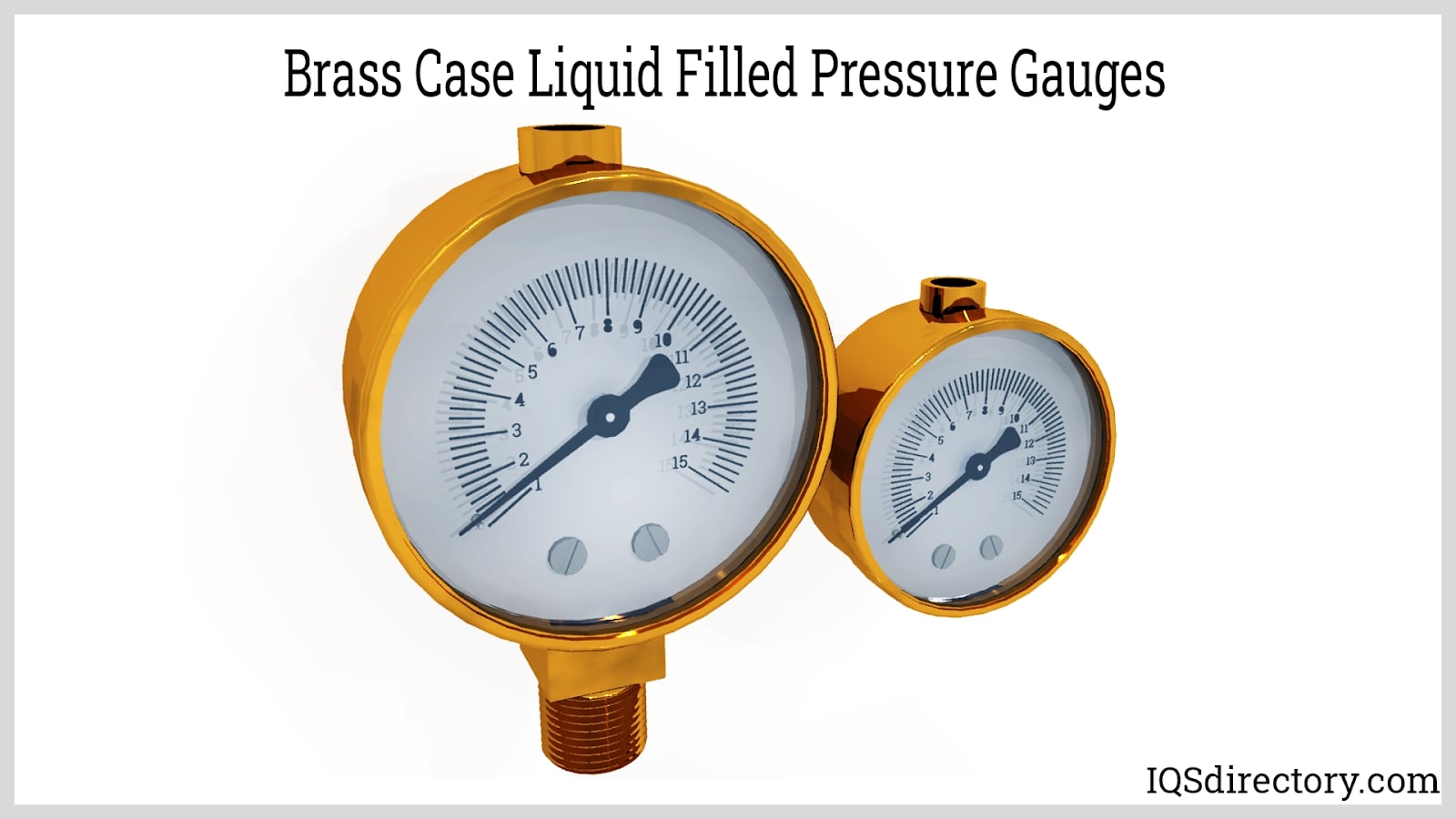 A pressure gauge measures the intensity of fluids, gases, water, or steam in pressure-driven equipment to detect leaks or changes in pressure that could impact system performance.
A pressure gauge measures the intensity of fluids, gases, water, or steam in pressure-driven equipment to detect leaks or changes in pressure that could impact system performance.
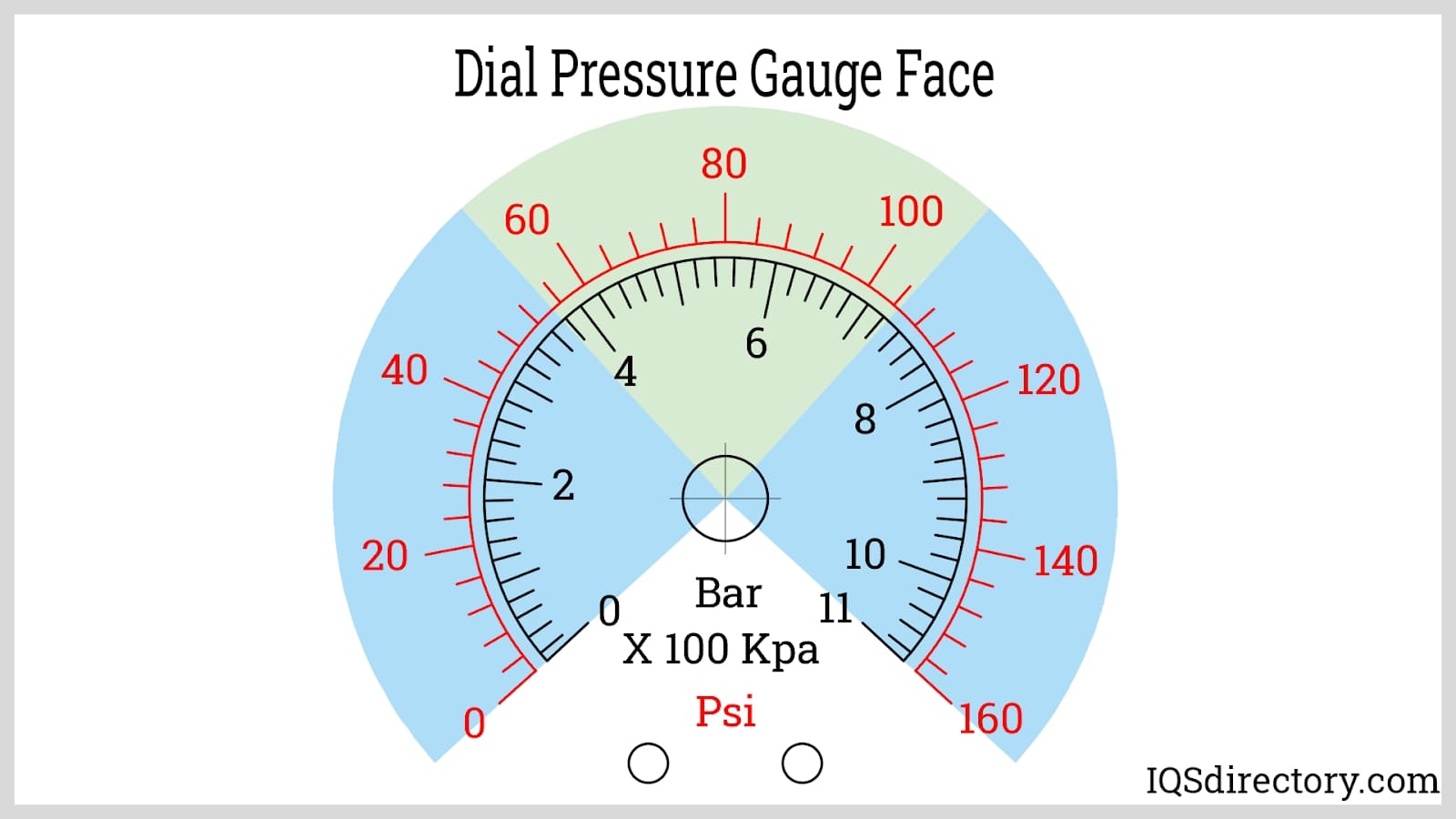 The scale is split into three segments, with the first and third being the least accurate, while the middle section provides the most accurate readings.
The scale is split into three segments, with the first and third being the least accurate, while the middle section provides the most accurate readings.
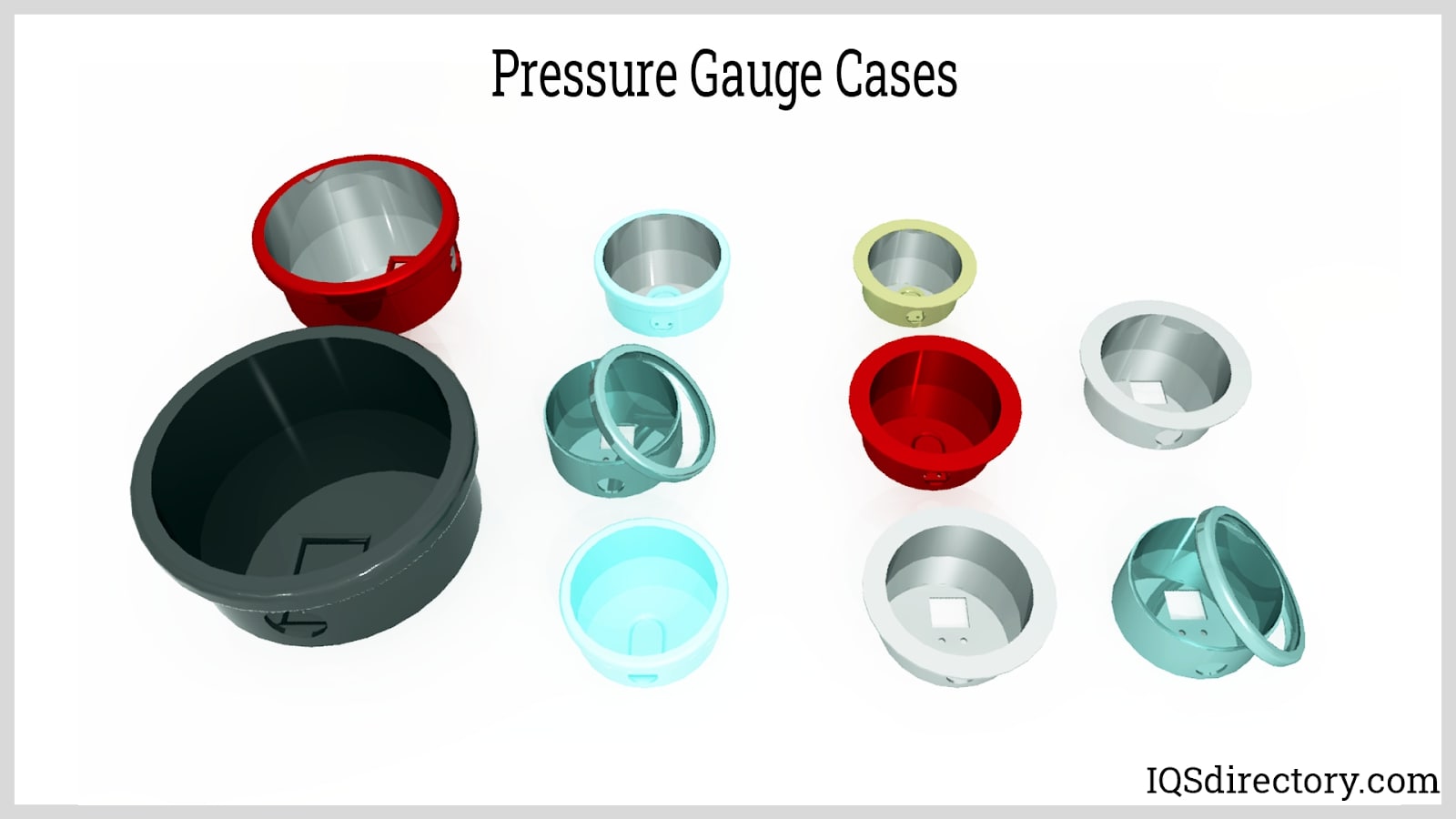 Pressure gauge cases are manufactured from plastic, steel, brass, or stainless steel.
Pressure gauge cases are manufactured from plastic, steel, brass, or stainless steel.
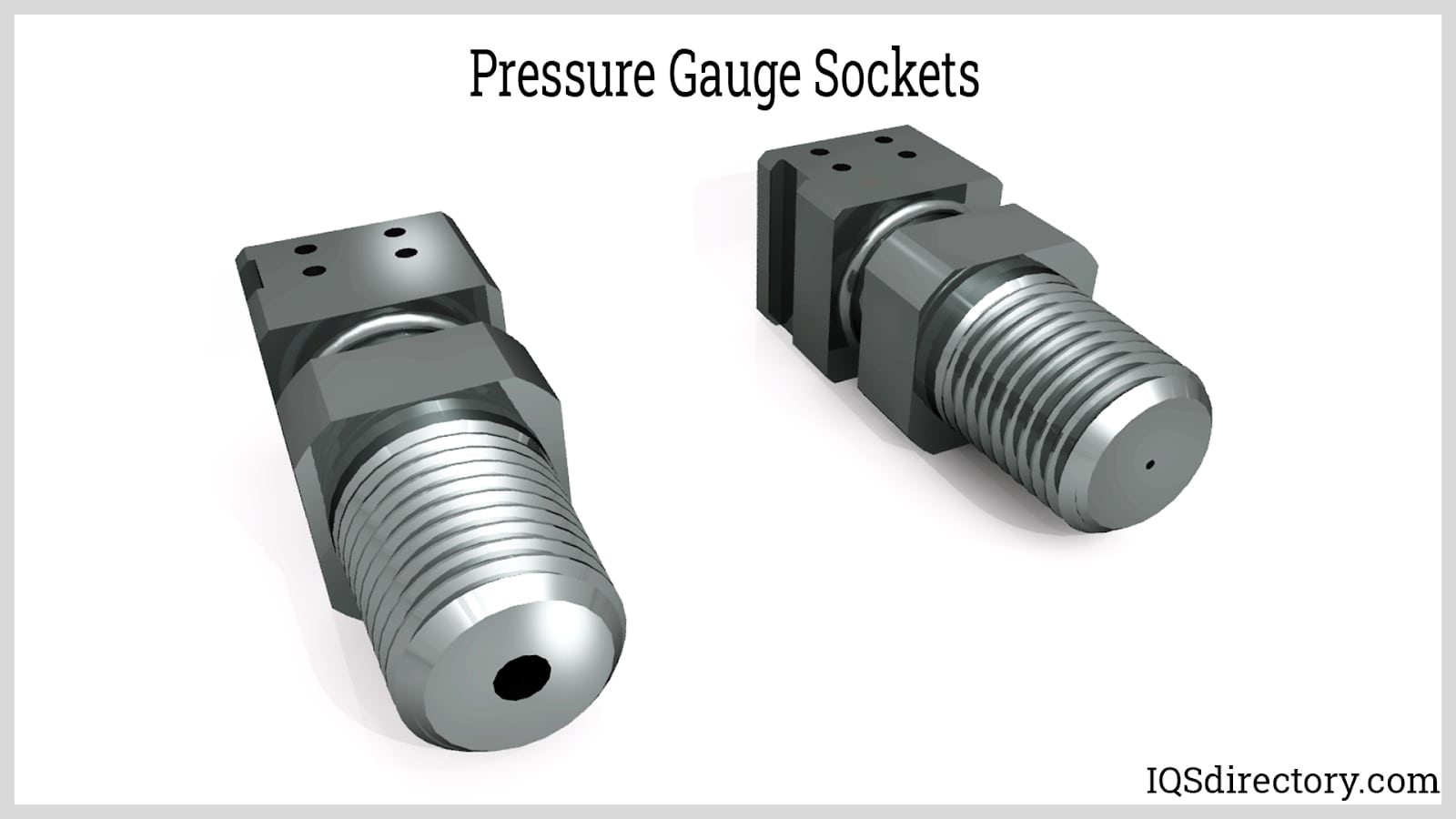 Sockets are the initial component in a pressure gauge that comes into contact with the pressurized fluid.
Sockets are the initial component in a pressure gauge that comes into contact with the pressurized fluid.
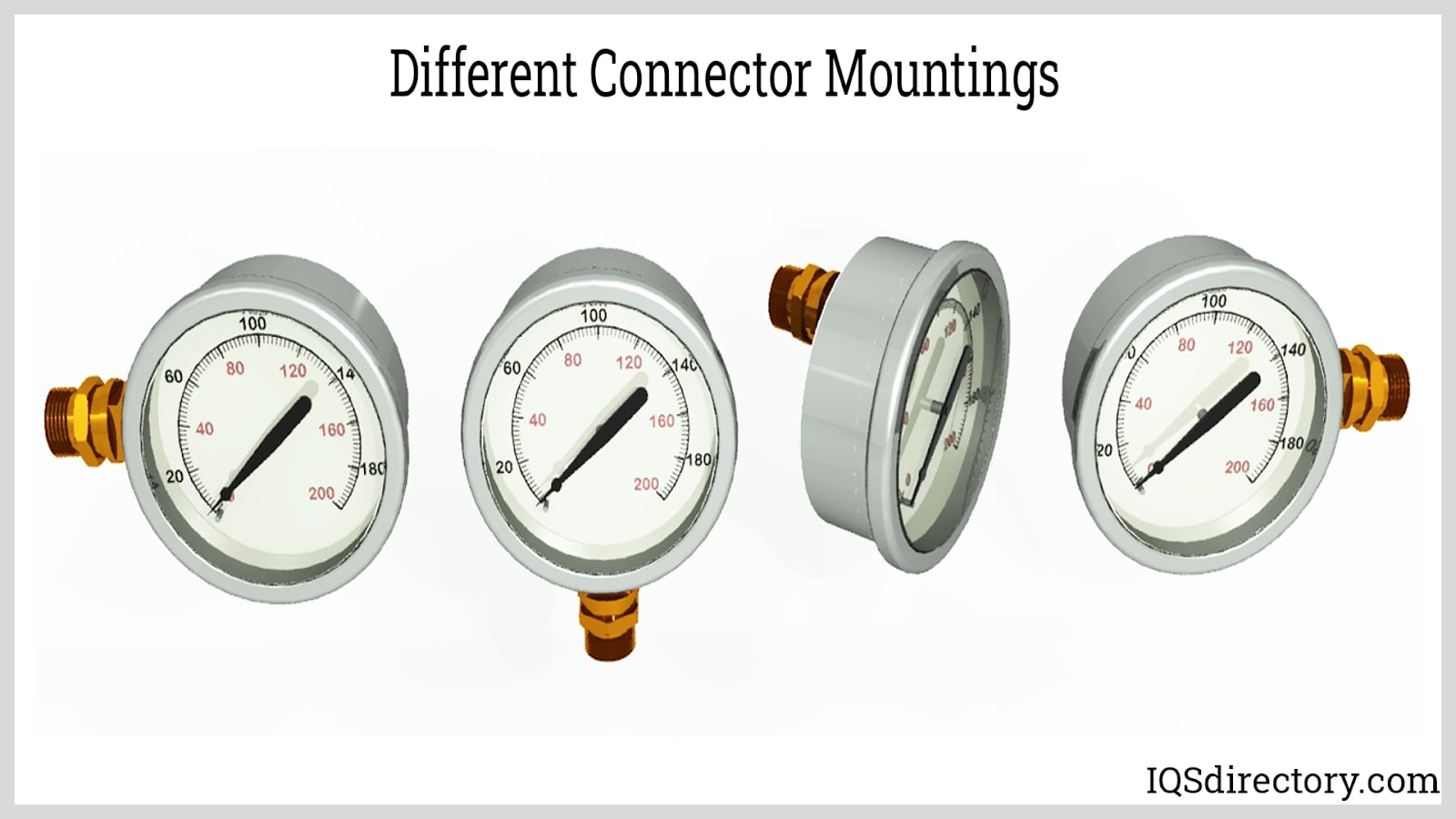 The size and orientation of the connection increases versatility—a lower mount gauge fits an upward-facing female connection, while a rear-facing connection can make the gauge harder to read.
The size and orientation of the connection increases versatility—a lower mount gauge fits an upward-facing female connection, while a rear-facing connection can make the gauge harder to read.
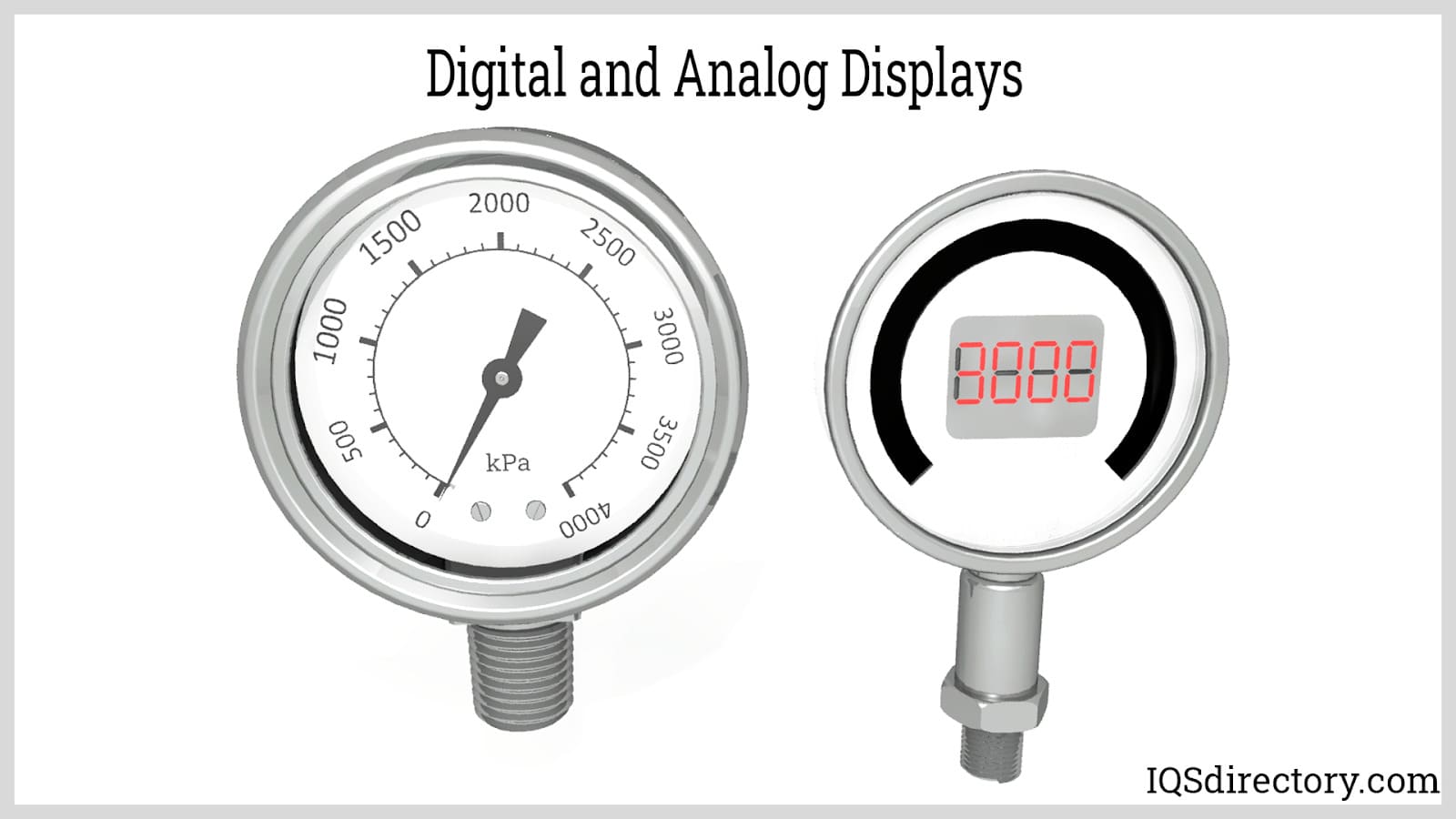 Pressure gauge displays can be either analog or digital, each offering distinct advantages for specific applications.
Pressure gauge displays can be either analog or digital, each offering distinct advantages for specific applications.
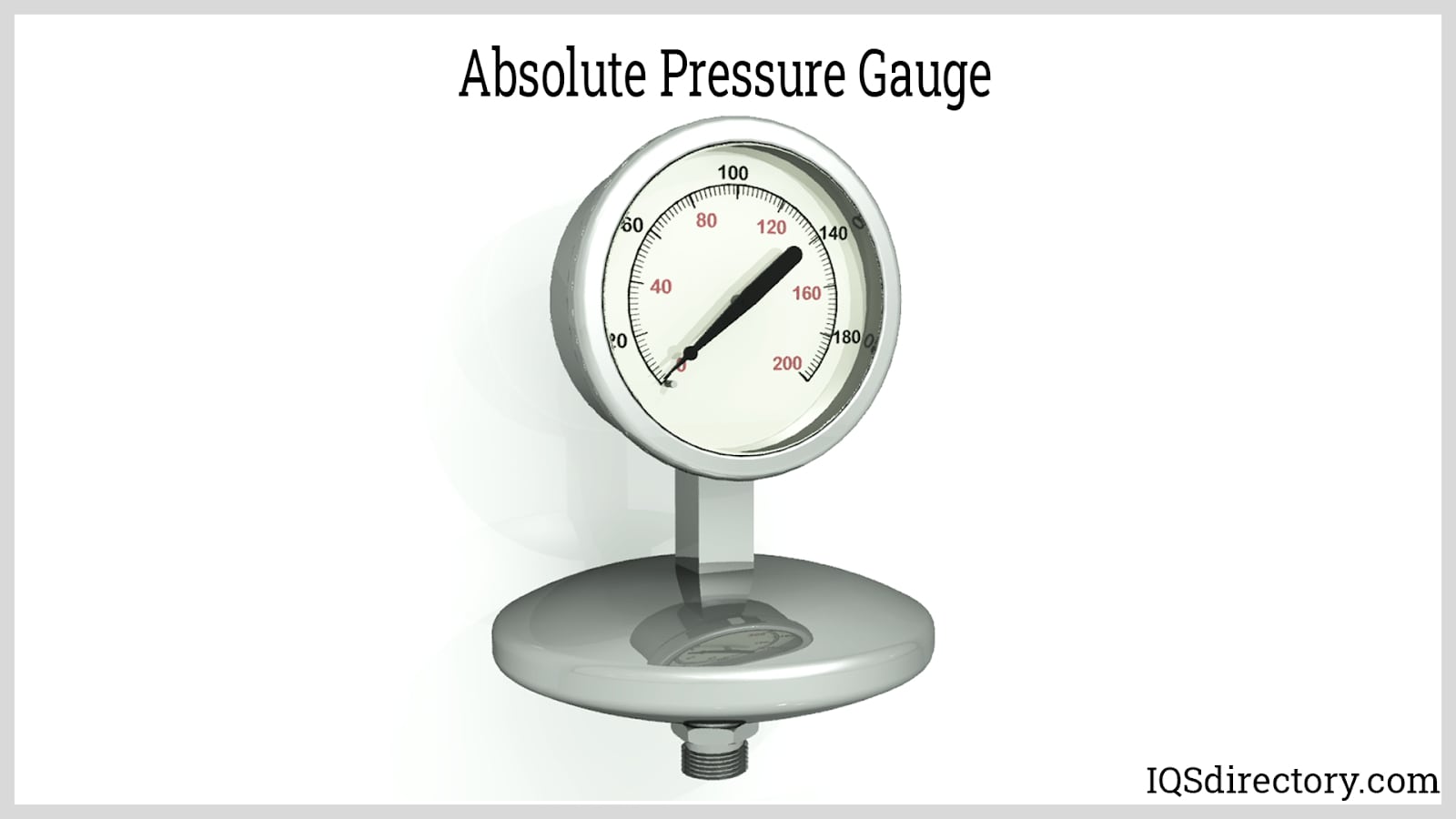 Absolute pressure gauges measure pressure levels independently of natural atmospheric pressure fluctuations.
Absolute pressure gauges measure pressure levels independently of natural atmospheric pressure fluctuations.
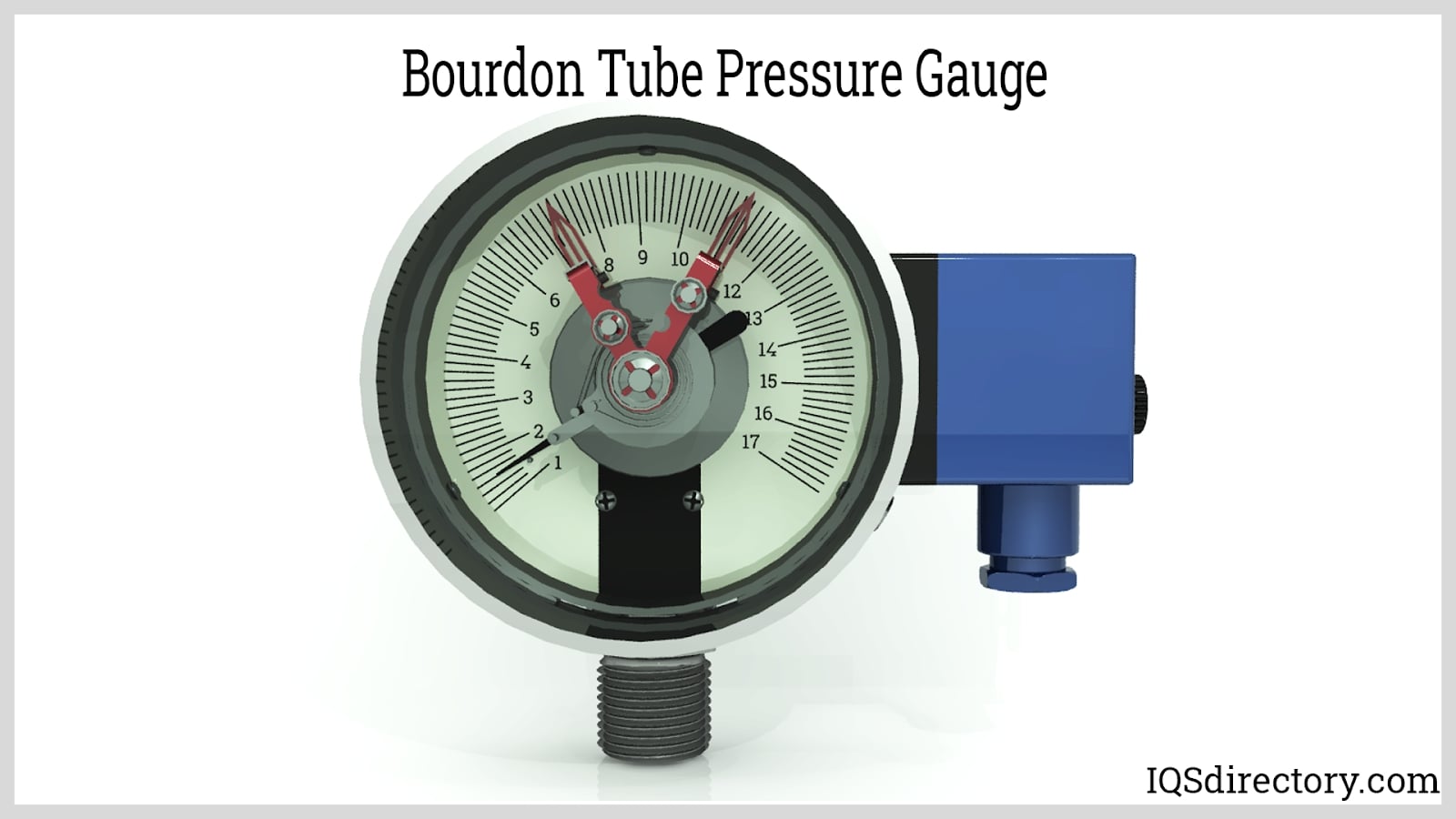 A Bourdon tube pressure gauge is capable of measuring pressures up to 1000 bar and as low as -1 bar.
A Bourdon tube pressure gauge is capable of measuring pressures up to 1000 bar and as low as -1 bar.
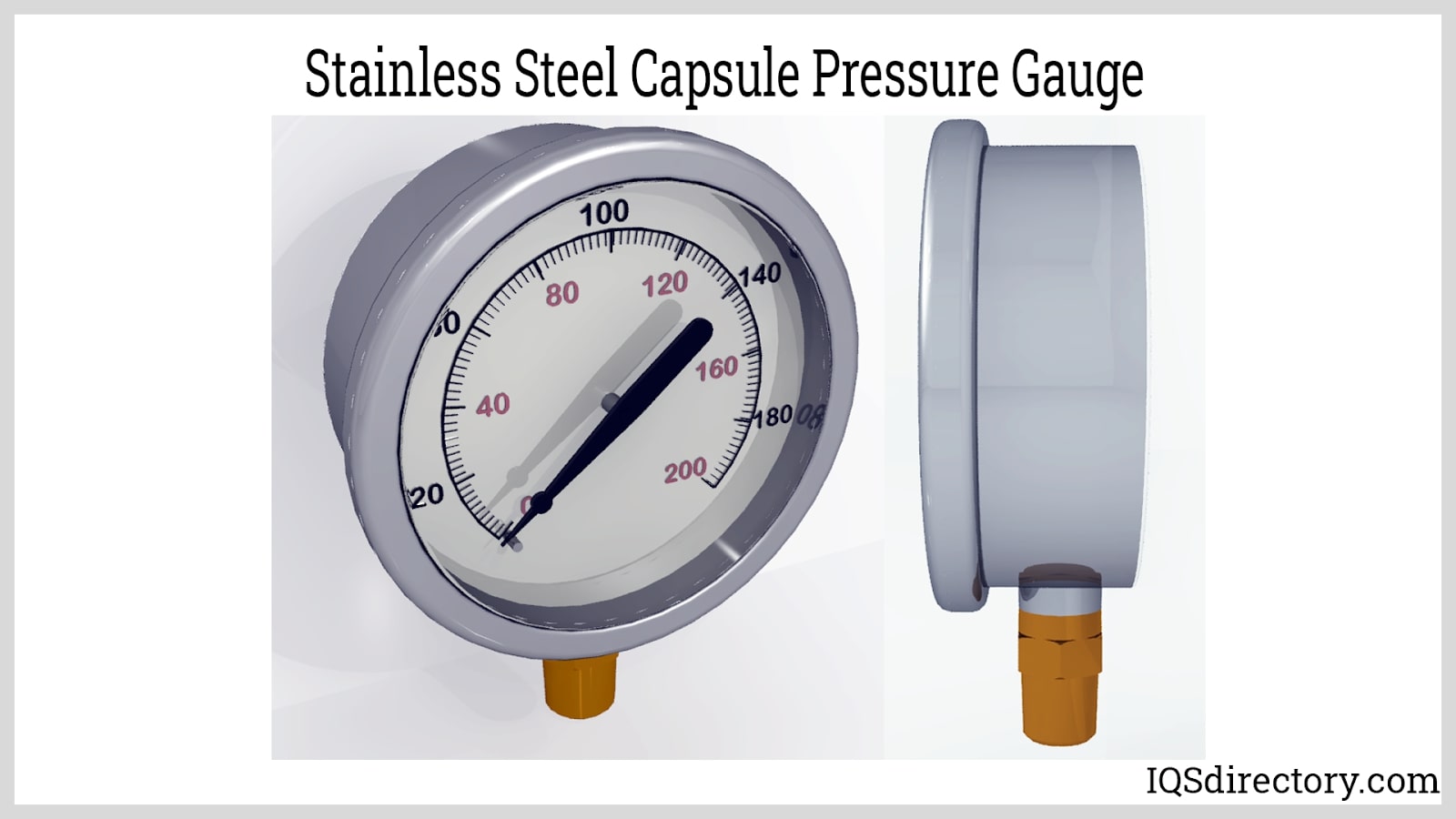 A capsule pressure gauge features two thin, concentric, corrugated diaphragms sealed together around their edges.
A capsule pressure gauge features two thin, concentric, corrugated diaphragms sealed together around their edges.
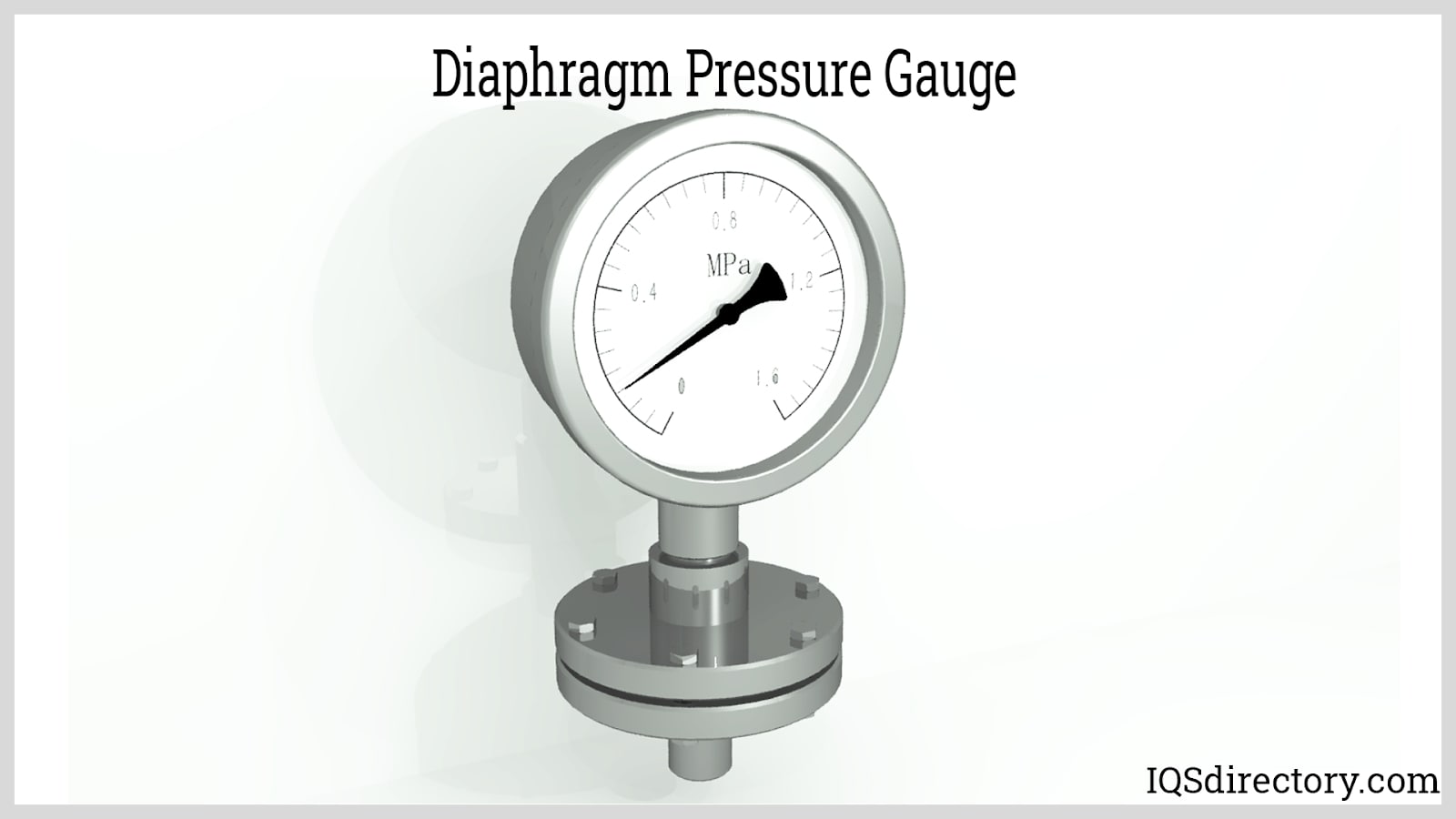 Diaphragm pressure gauges are designed to measure pressures ranging from 40 bar to -1 bar.
Diaphragm pressure gauges are designed to measure pressures ranging from 40 bar to -1 bar.
Types of Pressure Gauges
There are many different kinds of pressure gauges, and they are applied in all kinds of contexts.
- Air Pressure Gauges
- Measure pneumatic pressure in any air-operated equipment and can feature analogue or digital displays, as can most gauge varieties.
- Differential Pressure Gauges
- Instruments that measure the difference in pressure of a gas or liquid between two points. This eliminates the need for an operator or computer system to watch two gauges and perform the math. Differential pressure gauges are fast and efficient and immediately and constantly display information in one location.
- Water Pressure Gauges
- Monitor the pressure of any water-based system. These type pressure gauges are commonly attached to tanks that require monitoring of the liquid within.
- Fuel Pressure Gauges
- Instruments that specify the pressure of the fuel supply to the intake manifold in a combustion engine vehicle. This display represents how much gas is left in the tank.
- Oil Pressure Gauges
- Tools that measure the pressure of oil circulating in any lubricating system. Maintaining the correct amount of oil in a vehicle can increase its longevity; the same is true in machinery.
- Gas Pressure Gauges
- Measure and display the pressure of a gas. They are widely used by manufacturing plants or industrial companies where it is important to monitor any changes in pressure in order to control the rate of flow of gases such as propane or natural gas. They are used to measure very high pressures as well as low pressures.
- Vacuum Gauges
- Instruments used to measure and display sub-atmospheric or vacuum pressures within a system or vessel. Vacuums are frequently used to create cold temperatures for certain processes.
- Temperature Gauges
- Take measurements in a variety of materials including air, oil and water. They are used for home purposes as well as in scientific processes.
- Digital Pressure Gauges
- Attached to an instrument that measures the pressure of a gas or liquid and gives numerical readings. They display readings in digital, rather than analog, form. Digital readouts are typically easier to read and provide greater accuracy. They usually run on batteries and are available on most kinds of pressure gauges.
- High Pressure Gauges
- Instruments that measure and display the pressure of gases and liquids moving at high velocities. When the temperature rises or more gas and liquid is added to the container, the pressure increases even more. High pressure gauges are manufactured for industrial and manufacturing applications, mainly for high pressure hydraulic technology including water cutting machines, hydroblasting pumps and hydro-demolition. Some high pressure gauges are specifically designed for use in high purity semiconductor gas and liquid applications; they feature pressure ranges from less than 15 PSI to as high as 10,000 PSI.
- Low Pressure Gauges
- Generally measure pressures of 10 to 15 PSI. Gauges designed for low pressure are extremely sensitive and accurate out of necessity; many processes depend on the correct pressure to function properly and safely.
- Gauges
- Used in environments where the pressure tends to fluctuate frequently and so requires constant monitoring.
- Absolute Pressure Gauges
- Measure any pressure above zero pressure. It is impossible to create a perfect vacuum artificially, and no perfect vacuums exist on earth or anywhere in space. Absolute pressure gauges measure pressures on a scale that begins with zero, though a pressure of zero is impossible to achieve.
- Ambient Gauges
- Also called "sea level gauges," are the most commonly used gauge. They are used in meteorology. Ambient gauges are preset to read zero pressure at standard atmospheric pressure (~14.7 psi).
- Combination Gauges
- Measure both pressure and vacuum.
- Commercial Gauges
- Also referred to as "general purpose gauges" or "equipment gauges," are low-cost measuring instruments designed for applications that do not have severe conditions. Commercial gauges may be ruggedly constructed but are not typically economical to repair.
- Fuel Pressure Gauges
- Instruments that indicate the pressure of the fuel supply to the intake manifold in a combustion engine.
- Gas Pressure Gauges
- Instruments designed to measure and display the pressure of a gas.
- High Pressure Gauges
- Instruments that measure and display the pressure of gases and liquids moving at high velocities, up to 10,000 PSI, a very high pressure when compared to the atmospheric pressure of ~14.7 PSI.
- Industrial Gauges
- Have heavy-duty sensing elements and case designs and higher accuracy requirements than general purpose gauges. They are built for extended life and are designed for use in harsh environments.
- Liquid Filled Gauges
- Can be filled with various fluids, such as silicone oil, mineral oil and glycerin. The liquid fill provides protection to internal components of the gauge in severe environments in which the gauge may encounter excessive vibration and pulsation.
- Liquid filled gauges are utilized in nitrous systems on nitrous bottles or solenoids.
- Low Pressure Gauges
- Designed to accurately measure pressures less than 15 PSI using a capsule sensing element.
- Oil Pressure Gauges
- Instruments that measure and display the pressure of the oil in an enclosure, particularly oil circulating in a lubricating system.
- Precision and Test Gauges
- Extremely sensitive and highly accurate instruments that are used in applications that demand precision and consistent results, such as instrument shops, gauge repair and calibration shops and testing laboratories.
- Process Gauges
- Made from corrosion resistant material to meet the demanding heavy-duty operating and construction requirements of the chemical and petroleum industries. Process gauges are also designed to fulfill the exacting accuracy and service life needs of a variety of process applications.
- Retard Gauges
- Have a scale that is compressed at either one or both of its ends.
- Temperature Gauges
- Instruments that indicate the temperature of an item or substance being measured. The results may be displayed through an analog dial or digital readout.
- Vacuum Gauges
- Indicate negative atmospheric pressure or the degree of rarefaction below atmospheric pressure.
- Water Pressure Gauges
- Designed to determine and monitor the pressure of any system that uses water.
Pressure Gauge Accessories
Typical accessories for pressure gauges include diaphragm seals, valves, panel mounts, siphons, test plugs, snubbers, and pulsation dampeners.
Pressure Gauge Installation
During installation, ensure the pressure gauge is isolated from disruptive forces such as vibration, moisture, and extreme temperatures. Mount the gauge securely to a stable wall, panel, or surface away from piping strains. It is advisable to use a shut-off valve between the gauge and the system, allowing you to isolate the gauge for maintenance without interrupting the entire system. For further installation details, consult your supplier.
Standards and Specifications for Pressure Gauges
Pressure gauges used in the United States should comply with ANSI (American National Standards Institute) or ASME (American Society of Mechanical Engineers) standards to ensure quality and safety. For industry-specific requirements, contact relevant authorities.
Things to Consider When Purchasing Pressure Gauges
When selecting a pressure gauge, partner with a reputable manufacturer who understands your requirements. Review the list of providers at the top of this page and consider factors such as lead times, budget, compliance standards, delivery options, and post-delivery support like installation, calibration, or maintenance. Shortlist three or four promising suppliers, discuss your needs with each, and then compare your options to find the best fit.
Manufacturers designing custom pressure gauges take into account factors such as the intended environment, the type of substance being measured, frequency of use, and available installation space.
To enhance performance for specific applications, manufacturers may integrate the pressure gauge with related instruments like pressure transducers, strain gauges, pressure sensors, transmitters, or switches. These can be installed together or housed in a single enclosure, and can be fabricated in any size to fit your system’s requirements.
Proper Care for Pressure Gauges
Maintaining the safety and accuracy of pressure gauges requires regular inspection. Routine checks help detect potential issues early, preventing costly repairs or failures. The inspection frequency should be determined based on your application and in consultation with your manufacturer. Pay attention to signs of excessive wear, damaged sockets, or threads, and replace components as needed.
Pressure Gauges Terms
- Bourdon Tube
- A thin walled elastic tube of metal that is flat and formed into a circular shape, which tends to straighten in response to increases in pressure and is fixed to a pressure recording or indicating device such as a gauge.
- Pointer
- The part of the gauge that works with the dial to indicate the pressure level.
- Pointer Indication Adjustment
- A way of making a modification in indication with an adjustable needle with the change being the same over the whole scale.
- Pressure Relief Plug
- The insertion of a plug in the wall of the gauge that vents when there is an element leak to prohibit excess pressure build up in the case.
- Proof Pressure
- The highest pressure a gauge can maintain with no apparent alteration in accuracy.
- Pulsation
- A periodic pressure swell.
- Repeatability
- The highest difference from any two or more successive indications for identical working conditions and applied pressure.
- Restrictor
- The apparatus that limits the flow of fluid between the pressure element and the source of pressure.
- Retard Gauge
- The scale of this gauge is compressed at either one or both ends.
- Ring
- The part that firmly fixes the window to the case.
- Rupture Pressure
- The point at which a vessel's capacity to contain pressurized material is exceeded.
- Scale
- The markings on the dial comprised of gradations, related numbers and units of measure.
- Snubber
- An apparatus for the reduction of the effect of pressure variations and surges.
- Socket (Stem)
- The major supporting element of the pressure component assembly that the elastic component is fixed.
- Temperature Error
- The alteration of pressure indication that is caused by the difference of temperature in the components from the temperature at which they were calibrated.
- Wetted Parts
- Any element of a gauge that comes in direct contact with pressure media.
- Window
- A clear component made of glass or plastic closing the front of the case.